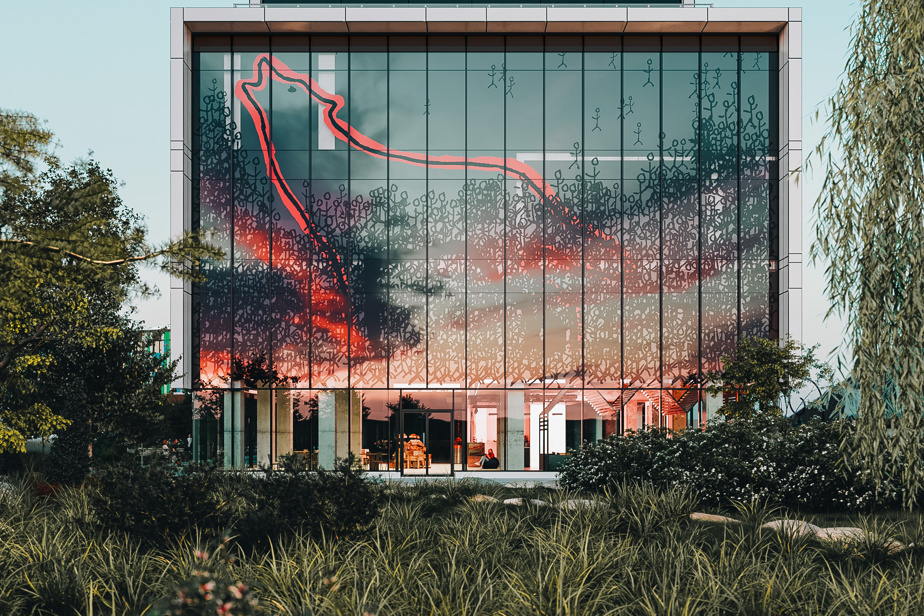The iconic Farine Five Roses brand, which welcomes motorists upon their arrival in Montreal, will have competition. Quebec artist Marc Séguin will put his signature on the facades of a rental building erected on the edge of the Bonaventure highway.
The announcement of this collaboration was made Tuesday on the ground floor of the Haleco real estate complex, currently under construction at the junction between Old Montreal and Griffintown. For several months, the renowned artist has been collaborating with Ivanhoé Cambridge, Cogir Immobilier and Pomerleau, developers of the project, as well as with its designers, the firms ACDF Architecture and l’ŒUF.
Marc Séguin says he was approached by the team of architects to add “oomph” to this project, winner of the international Reinventing Cities competition, organized by the C40 global network of major cities.
“I went to pitch my thing with my foot in the ground, saying to myself: ‘This is the fantasy of what I would like to see in urbanity,’” says Marc Séguin. We had to convince people, but it worked. »
The work is structured around two figures: on one facade, that of the she-wolf who rallies her clan and on two others, that of the circle, symbolizing at the same time an Earth floating in space, the Moon, the light of a lighthouse and the movement of the blades of a mill which once stood on the site. “I deeply wanted to mark the territory,” declares Marc Séguin. The work is called Assembly Point, like those places we find near airports, at the exit of buildings, where we say: “Let’s gather here to leave for other bases”. »
Based on the artist’s sketches, developed according to precise budgetary criteria, notably the use of a maximum of four colors, the work was printed on the panels of the exterior envelope of the building. The she-wolf is already visible, the circles will be visible later. “Look around, the buildings are generic,” laments Marc Séguin. This one is special. It’s a new way of building for the future, of lasting sustainability with social and affordable housing. »
This 21-story complex will feature 327 rental homes, including 77 affordable homes, offices, circular economy-focused businesses on the ground floor, and an associated housing cooperative of 40 social housing units. Green spaces will occupy 57% of the land, and space will be given to urban agriculture, underground.
For Mayor Valérie Plante, the strategic location of the land, on which there was a road yard, required a strong signature. “We must have more beauty, works that are dynamic, buildings that speak,” says Ms. Plante. This is what interests me when I visit a city. We have murals, it’s great. But there, it’s like a mural forever integrated into the entrance to the city. »
According to Marc Séguin, Montreal is in great need of contemporary iconic buildings. “Expo 67, the Olympic Stadium, that’s what we show on TV, what we show from Montreal. Mount Royal does its job, but there are no other buildings,” notes the one who advocates the creation of a “ministry of beauty.”
Adding beauty to this building was a challenge for the architects who had to deal with constraints linked to the energy efficiency of the building. According to Joan Renaud, project architect and partner at ACDF Architecture, this explains why the final architectural style of the project is so different from that which was presented to the Reinventing Cities competition, which aims to encourage low-emission urban revitalization. of carbon. On the original sketches, there were several facade overhangs which had to be removed to reduce thermal bridges and maximize the energy efficiency of the building. “The project was rationalized and simplified in many aspects to meet these energy criteria,” explains Joan Renaud. We ended up with a building that was quite coplanar, with few overhangs and little extravagance, but it became an incredible urban canvas that we had to use to create something quite distinctive, strong enough to become a door. entry point into the city and a gathering point for the community. »
Under the Reinventing Cities competition philosophy, the project will attempt to address 10 climate challenges, including energy efficiency, climate resilience, sustainable water management, and social inclusion and community engagement . It aims to obtain LEED Platinum certification. The first tenants are expected to move in in 2024.
